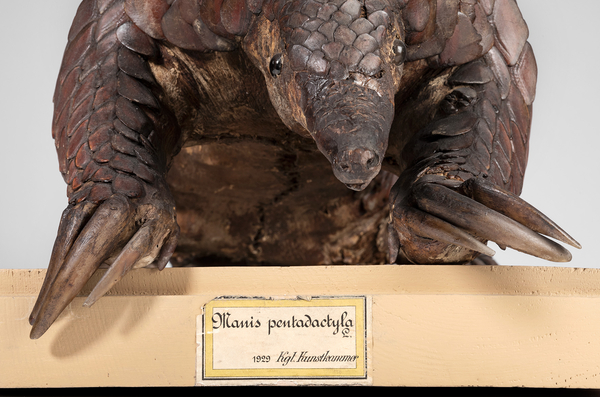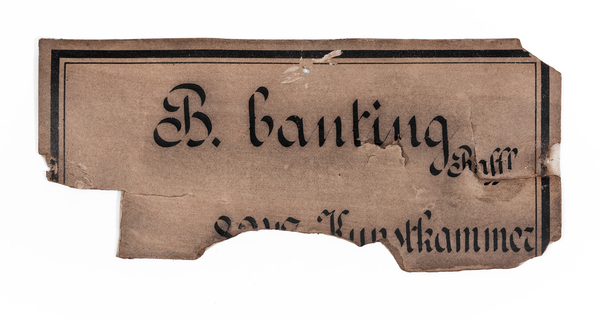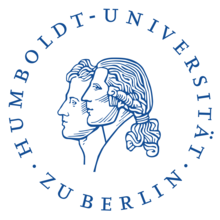The Detail Search [Detailsuche] function of the research environment provides access to various kinds of information on the origin of the objects collected in the Brandenburg-Prussian Kunstkammer. All of the information is based on the sources analyzed in the project, which range from seventeenth-century manuscripts to the object databases of modern-day museums. The information on provenance includes localities and production sites as well as data on the acquisition of the objects associated with other collections and individual persons.
The primary focus is on the path of the objects into the Kunstkammer of the Berlin Palace. In isolated instances, however, indications of provenance such as the phrase “Kgl. Kunstkammer” (“Royal Kunstkammer”) in the collection catalogues and on the labels of the Zoologisches Museum also permit us to trace the objects’ transfer from the Kunstkammer to other institutions.
The accession books of the late 1680s and early 1690s contain information on previous locations such as the “Schilderey Cammer,” as well as on former owners and suppliers who provided the objects to the Kunstkammer administrators. Those mentioned by name in these sources are mostly identified as simply officials or persons associated with the court; occasionally even the elector himself appears as a collector. Only rarely can the persons be further identified. We know, for example, that Elias Hesse—who in March 1692 supplied the Kunstkammer with objects including a “Pulferhorn” (“powder horn”) and “ein Büchlein darin Unterschiedlich Indianische Nations abgezeichnet” (“a little book listing various Indian Nations”)[1] – had traveled around the Cape of Good Hope to Sumatra in the service of the Dutch East India Company.[2]
The names and titles of other previous owners make visible the various connections of the Berlin Kunstkammer. The travel harpsichord of the duchess of Orléans and the “Royal Prussian Coat of Arms” embroidered by nuns in Kalkar situate Prussia within the political network of early modern Europe. Locations at closer geographical or dynastic proximity are mentioned in a much more differentiated way in the historical lists and travel reports than faraway regions, which are recorded in more generalized, such as “Africa” or “West Indies.”
Only occasionally do the early modern accession books of the Kunstkammer mention an object’s region of origin, as with porcelain clay from China or cotton from India. Not until the nineteenth century were places of origin or discovery sites systematically integrated into the collection catalogues on which modern-day museum databases are based. The information recorded there, along with the results of subsequent art historical research, permits the stylistic attribution of artifacts to, for example, artistic circles in Nuremberg around 1600, Augsburg around 1700, or the Netherlands in the 1470s. The provenance data for the drinking vessel of zebu horn tells us where the object was (probably) produced; regarding the origin of the material, however, the sources remain silent. Relatedly, the place names in historical collection catalogues often refer to political entities that no longer exist or identify the place of discovery only vaguely in comparison to modern-day scientific documentation.
With awareness of these limitations, the places of origin documented in the sources were georeferenced during the research project and can now be searched on a map. By default, historical place names appear at the center of modern-day states, thus providing additional means of access to the objects from the Brandenburg-Prussian Kunstkammer and their history. More detailed research on individual objects allows the georeferencing to be refined without repeating the imperial and colonial impulses of early modern rulers. For example, ethnologists have identified the origin of the “magic drum” exhibited in the Berlin Kunstkammer in the eighteenth century as the northern Scandinavian region between the Pite River in the north and Ume River in the south, where the Ume Sámi language is spoken. Thus instead of using the center of the modern nation of Sweden, thereby echoing the imperial ambitions of an early modern kingdom, the object’s origin was identified and visualized on the map on the basis of current scholarly research.
Meike Knittel
[1] Eingangsbuch 1688/1692b, fol. 25r.
[2] Hesse 1690 - Ost-Indische Reise-Beschreibung Oder Diarium, Was bey der Reise des Churfürstl. Sächs. Raths und Bergk-Commissarii D. Benjamin Olitschens/ im Jahr 1680. Von Dreßden aus biß in Asiam auff die Insul Sumatra Denckwürdiges vorgegangen / auffgezeichnet von Elias Hessen, Leipzig/Dresden 1690, online unter: http://dx.doi.org/10.25673/opendata2-30546
For more on this topic, see
Meike Knittel, “Crystalline Gold from Sumatra: Of Wealth and Exploitation,” in The Berlin Kunstkammer: Collection History in Object Biographies from the Sixteenth to the Twenty-First Century (Petersberg: Imhof, 2023).




